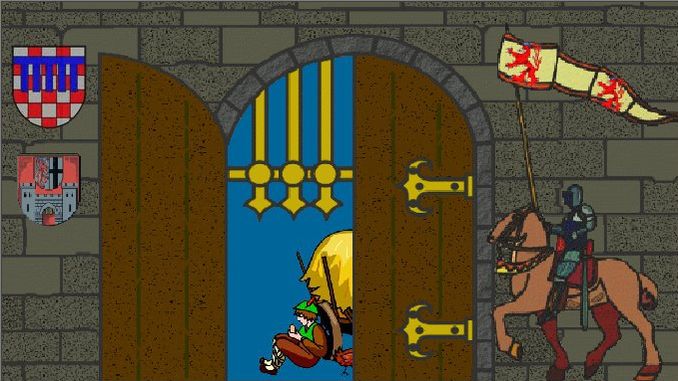
There is a lot to report and above all to see from the late Middle Ages in the Siebengebirge as well. Large parts of Cologne Cathedral were built with stones from Mount Drachenfels; the coats of arms of the Siebengebirge towns Bad Honnef and Königswinter date back to the reigns of those times.
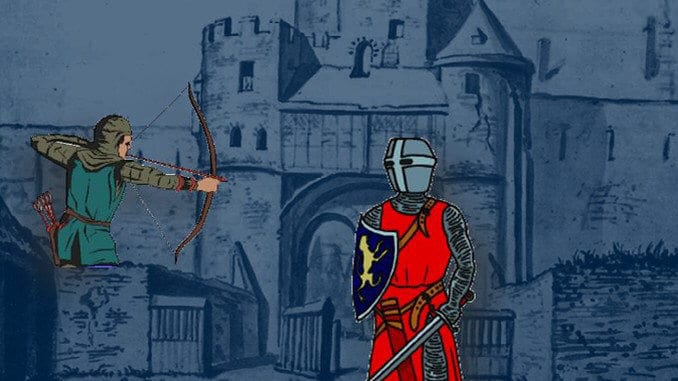
Interregnum, Holy Roman Empire
After the death of Frederick II, the Hohenstaufen Empire collapsed. His sons Manfred and Conrad and his grandson Conradin died in battle, fighting for their inheritance. Southern Italy was lost forever. In the Holy Land, the end of the Crusader States became apparent. The Latin Empire in Byzantium collapsed already in 1261.
A period of upheaval
In Germany, there were kings, sometimes several at once, but in name only, none of them could assert his authority against the mighty princes. Thus, chaos ruled until it was enough even for the princes. In 1273, they elected Rudolf of Habsburg (1273-1292). He became a very popular king because he fought to restore order and justice in the country. He also tried to regain former imperial territories and obtained the territories in Austria that a bit later formed the Habsburgs’ power base.
Edward I and Philip IV
Whereas in the Empire the true power was with the dukes, powerful monarchs without scruples ruled abroad. Edward I “Longshanks” of England, who fought the “Bravehearts” of Scotland, and Philip IV “the Fair” of France, who destroyed the Order to the Temple and even gave orders to assassinate the Pope. Soon, under the influence of the French King, the Popes left Rome and took their seat in Avignon (1309-1379).
Back then in the Siebengebirge
Löwenburg
Count Heinrich III von Sayn had been a mighty man in the empire and in our region. Yet, he and wife Mechthild had no children. When he died 1247, Sayn county went over to his sister’s family. His successors, the Lords of Sponheim and then the Lords of Löwenberg, were unable to maintain this prominent position.
The next generation on Löwenburg Castle, the Lords of Löwenberg, namely Johann I and Heinrich I, built the castle whose ruins we see today.
Stones from the Drachenfels for the cathedral in Cologne
In art, the Gothic style now prevailed also in Germany. In 1248, Archbishop Konrad von Hochstaden laid the foundation stone for the new Gothic cathedral in Cologne. A good time for the burgraves of Drachenfels began: the trachyte of the Drachenfels was the perfect stone. In 1273, the burgrave and the Cologne Cathedral chapter signed a treaty on quarrying trachyte from the Drachenfels for the cathedral – an enormous project that quickly brought the burgraves a considerable fortune.
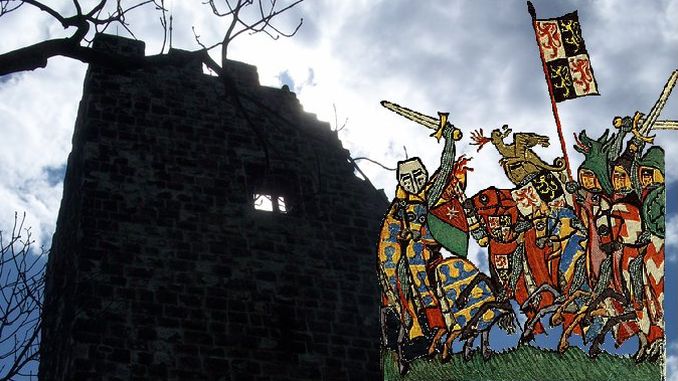
Battle of Worringen
Throughout the Middle Ages, the Archbishops of Cologne were important political actors in the Empire and in our region. Here, however, their supremacy was more and more questioned by the Counts of Berg on the right side of the Rhine. In the city of Cologne, the mighty and wealthy citizens wanted to get rid of the archbishop’s rule.
In the 1280s, the war of the Limburg Succession between the Archbishop Siegfried II of Cologne and Duke John I of Brabant raged and led to the bloody battle of Worringen 1288. The Archbishop and his allies, among them the burgraves of Drachenfels, Wolkenburg and the Count of Löwenburg, suffered a terrible defeat. The burgraves were taken prisoner by the Count of Berg and had to pledge loyalty to him.
The Archbishops’ supremacy in the Rhineland was gone, and so was their hold on Cologne.
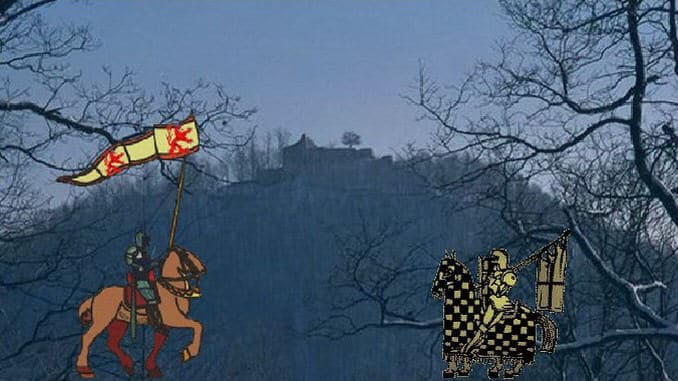
The House of Luxemburg
Under Charles IV (1346-1378), the House of Luxembourg raised to be the most powerful in the Empire. Having his roots in Bohemia, he made Prague his capital. The “Golden City” came into being with the Charles University in 1348, the first German university in the kingdom, the Charles Bridge over the Vltava River, the Gothic St. Vitus Cathedral and the Castle Karlštejn.
In 1356, the King legislated the so-called Golden Bull, in which he stipulated that the seven prince-electors elected the King, and guaranteed them the sovereignty and integrity of their territories.
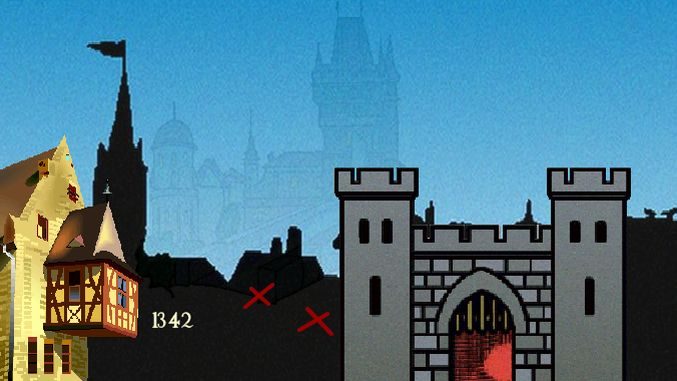
Flood and black plague
In July 1342, a devastating flood catastrophe swept over large parts of Europe – St. Mary Magdalene’s flood, around July 22. It devastated large parts of Germany and paved the way for the plague.
The black plague stroke large parts of Europe, during the years 1347-1351 alone a third of the population died. There was no remedy, and people thought that God had abandoned them.
They had no more trust in the clergymen because many of them led a life of luxury, even excesses, and they did not know what to answer the people in pain. In those apocalyptic times, the “flagellants” appeared, people who walked through the streets flagellating themselves, asking God for forgiveness and salvation from the black plague. With time, the authorities felt threatened by the flagellants and persecuted them.
Again the Jews were accused, persecuted and many people were killed. Charles IV did not protect them, although it was his royal duty since the Jews paid an enormous amount to the emperor for their safety.
Western Schism
The year that Charles IV died, the Western Schism occurred (1378-1417). That is to say there were two, later even three Popes, all with their obediences and political alliances, who fought one another.
Charles’ son Wenceslaus (1378-1400) in Prague was incompetent and tyrannical. The prince-electors deposed him and put the Palatine elector Ruprecht I (1400-1410) on the throne. However, he had neither money nor luck and died shortly afterwards. His successor was Sigismund of Luxembourg (1410-1435).
Sigismund managed to summon the Council of Constance to solve the Western Schism. But they did not manage to reform the Church. Moreover, they accused the reformer priest Jan Hus of Prague of heresy, found him guilty and burned him on the stake. That caused a rebellion in Bohemia. For some twenty years, the Hussite wars devastated large parts of the Empire (1419-1436).
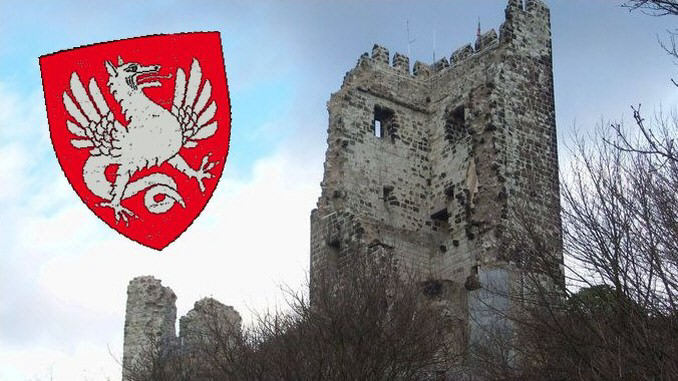 Medieval castles
Medieval castles
Read more about the medieval castles in the chapter on castle ruins
Drachenfels Castle
Löwenburg Castle
Rosenau Castle
Back then in the Siebengebirge
The most powerful men were the counts, from 1380 onwards, the dukes of Berg. They kept fighting against the Archbishops of Cologne over predominance. Again and again both sides raided our region. Back then, the town of Königswinter was fortified by a city wall, and the Löwenburg castle by an outer bailey. Eventually, in 1484, Löwenburg Castle and the estates around it fell to the counts of Berg.
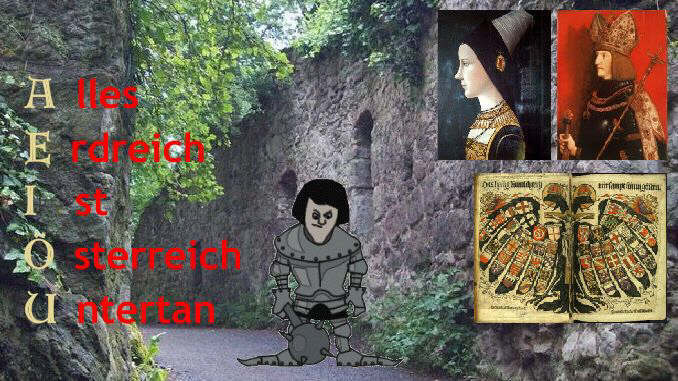
The House of Habsburg
After the Sigismund’s death, his son-in-law, Albrecht II of Habsburg (1438-1439) ascended the throne. From that day on, the crown remained with the house of Habsburg. Albrecht II died already two years later in combat against the Turks.
Fighting the Turks
The Ottoman Empire continued expanding. In the battle of Kosovo 1389 they had defeated the Serbs. Some years later in 1396, in the battle of Nicopolis, they overwhelmed a Christian army under Sigismund.
Finally, in 1453, Byzantium fell to the Turks. The Byzantine Empire disappeared, giving way to the consolidation of the great Ottoman Empire. Only Hungary remained between the Ottoman Empire and the Holy Roman Empire. At that time, the name of Holy Roman Empire of German Nation became popular.
Frederick III
The long reign of Frederick III (1440-1493) was a time of political stagnation. Nevertheless, he was quite a successful king because he lived very long and could see his enemies die before him and inherit them. Charles the Bold, Duke of Burgundy, had refused his approval to the marriage of his daughter Maria and Frederick’s son Maximilian.
In 1474/75, two rivaling Archbishops fought one another in the Archbishopric of Cologne. One party called Charles the Bold for help, thereupon he besieged the city of Neuss for ten months. That brought Emperor Frederick III into the arena. He gathered a huge imperial army and marched with his army upon Neuss. Charles the Bold had to withdraw. On its way, the imperial army conquered the town of Königswinter, and also the burgrave of Drachenfels capitulated.
Maximilian I
When Charles died in combat, Maximilian could marry Maria, and with her, he gained Burgundy’s rich territories including the Netherlands. After his father’s death, Maximilian ascended the throne (1493-1515). His reign is a time of transition between the Late Middle Ages and the Modern Age. As first king, he became Emperor in 1508 without being crowned by the Pope.
Late Middle Ages | Read More
Battle of Worringen
Intro Middle Ages | Ottonian and Salian Dynasties | Hohenstaufen Dynasty | Late Middle Ages

Be the first to comment